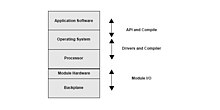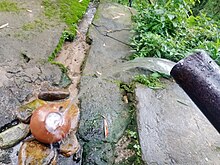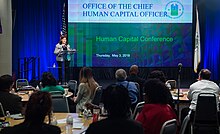Resources
Resource refers to all the materials available in our environment which are technologically accessible, economically feasible and culturally sustainable and help us to satisfy our needs and wants.
A natural resource is anything obtained from the environment to satisfy human needs and wants.[1] From a broader biological or ecological perspective, a resource satisfies the needs of a living organism (see biological resource).[2]
Computer resources[change | change source]

A computer resource is any physical or virtual component of limited availability within a computer or information management system. Computer resources include means for input, processing, output, communication, and storage.[3]
Natural[change | change source]


Natural resources are derived from the environment. Many natural resources are essential for human survival, while others are used to satisfy human desire. Conservation is the management of natural resources with the goal of sustainability. Natural resources may be further classified in different ways.[1]
Labour or human resources[change | change source]
In economics, labor or human resources refers to the human effort in the production of goods and rendering of services. Human resources can be defined in terms of skills, energy, talent, abilities, or knowledge.[4]
In a project management context, human resources are those employees responsible for undertaking the activities defined in the project plan.[5]

Tangible versus intangible[change | change source]
Whereas, tangible resources such as equipment have an actual physical existence, intangible resources such as corporate images, brands and patents, and other intellectual properties exist in abstraction.[6]
Related pages[change | change source]
References[change | change source]
- ↑ 1.0 1.1 WanaGopa - NyawakanMiller, G.T.; S. Spoolman (2011). Living in the Environment: Principles, Connections, and Solutions (17th ed.). Belmont, CA: Brooks-Cole. ISBN 978-0-538-73534-6.
- ↑ Ricklefs, R.E. (2005). The Economy of Nature (6th ed.). New York, NY: WH Freeman. ISBN 0-7167-8697-4.
- ↑ Morley, D. 2010. Understanding Computers: Today and Tomorrow, 13th ed. Course Technology, Stamford, CT. ISBN 0-538-74810-9.
- ↑ Samuelson, P.A. and W.D. Nordhaus. 2004. Economics, 18th ed. McGraw-Hill/Irwin, Boston, MA. ISBN 0-07-287205-5.
- ↑ Hut, PM (7 September 2008). "Getting and Estimating Resource Requirements - People". Pmhut.com. Retrieved 2 January 2012.
- ↑ Berry, John. 2004. Tangible Strategies for Intangible Assets. McGraw-Hill. ISBN 978-0071412865.
on other wikis[change | change source]
 The dictionary definition of resource at Wiktionary
The dictionary definition of resource at Wiktionary
